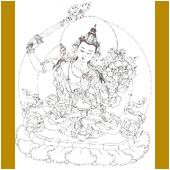
T
Ta Keo
"Tower of crystal." Shaivite temple located in Angkor, built by Jayavarman V
in the late 10th and early 11th centuries C.E.
Tantra
A type of Vajrayana Buddhism important in northeastern India after the 8th
century C.E., and still surviving in Nepal, Tibet, and Mongolia. It expanded
the Buddhist pantheon, and placed a greater importance on exotic practices based
on the tantra.
Taoism
An influential philosophy in China, founded by Lao Tzu probably in the 4th century B.C.E. Tao-te Ching or "the Book of the Way" is attributed to Lao-tzu
and is the basis of philosophical Taosim. Tao is the all-embracing, ultimate,
and primordial principle. The goal is to become one the the Tao by realizing
the universal law of the return of everything to its source.
Tavatimsa
The heaven of thirty-three gods, presided over by Indra, and one of the heavens,
which can be reached by accumulated merit. The Buddha spent one rainy season
in this heaven preaching to his mother who had died shortly after his birth.
The Buddha descending from Tavatimsa heaven is a common scene in temple murals
in Southeast Asia.
Tazaung
Small pavilions found within Buddhist temple complexes in Burma. thangka Cloth,
often silk, painted with Tibetan Mahayana deities; also an object of veneration
and inspiration for meditation. terra cotta Hard, brownish-orange clay used
for architectural decoration, figurines, and pottery.
Thangkas
These are uniquely Tibetan. They are almost like mandalas, conceived and prepared in the same manner, but they are paintings also invested with the spirit of a deity to whom they are consecrated. There are numerous thangkas as there are Buddhas and Buddhisattvas in the Buddhist pantheon. The deity is usually painted in the middle. They are also ritual artifacts, worshipped like icons. Unlike icons, they are light and therefore can be carried around by the devotee.

Thephanom
The figure of a deva or devi in a worshiping gesture in Thai art.
Theravada
"Words of the elders" or "teachings of the elders." A Hinayana sect that spread
from India to Sri Lanka and Southeast Asia, where it is the dominant form of
Buddhism. Its texts are written in the Pali language.
Thorani
The earth mother that appears as a witness to the Buddha's accumulated merit
just before the moment of his enlightenment. In art, she is often depicted as
wringing water from her hair. "Calling the earth (mother) to witness" is a popular
hand gesture in Buddhist iconography. See bhumisparsamudra.
Trigram
Symbol indicating the eight points of the compass used by geomancers. Each trigram
consists of a different combination of three lines. The lines may be broken
in the middle (yin) or unbroken (yang). When used for divination, trigrams are
arranged in a circle with yin and yang signs in the middle. Seen as a decorative
motif on ceramics, buildings, and textiles.